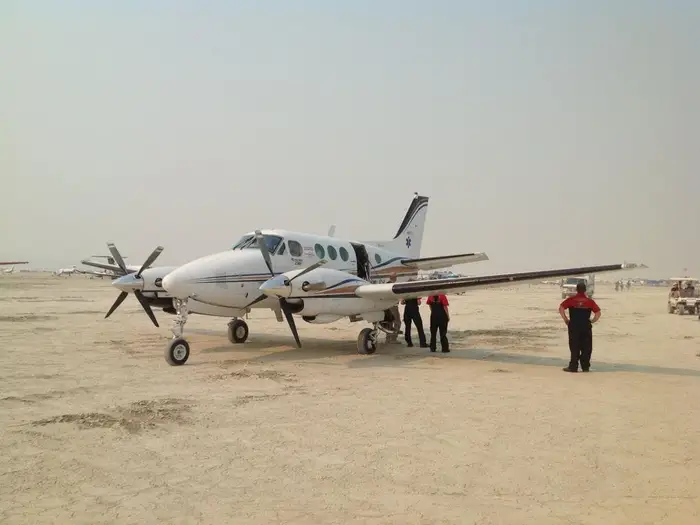Private planes, charter jets, and shuttle flights bound for Burning Man have been forced to stop flying into Black Rock City after a powerful storm swept across the Nevada desert.
Nearly 100 aircraft had already touched down at the festival’s temporary airstrip, known as 88NV, before operations abruptly ceased on Sunday evening. Since then, only an emergency air ambulance has been cleared to land.
The airport—built from scratch each summer about a mile and a half outside the city center—typically becomes one of the hundred busiest airports in the U.S. during the festival week. By Monday morning, however, the runway was still closed as organizers evaluated conditions, hoping to reopen by midday despite more rain looming in the forecast.
Weather disruptions aren’t new to Burning Man’s aviation operations. During the famously flooded 2023 event, a small plane was stuck on the Playa for weeks after being damaged by mud, according to the 88NV Pilot Survival Guide.
The airport handles a mix of private, charter, and shuttle flights, including the popular Burner Express Air service that connects the Playa with Los Angeles, the Bay Area, and Reno. Tickets run between $900 and $2,400 each way, with full-aircraft charters topping out around $18,000. Demand has jumped more than 20% this year, according to a Burner Express spokesperson; last year, the service flew 2,184 passengers.
Although luxury air travel might appear to clash with Burning Man’s principles of decommodification and ‘leave no trace,’ the airport itself is built and run almost entirely by a volunteer crew of about 400 people. Planes have landed at the Playa since 1991, but the airport didn’t receive its official FAA identifier, 88NV, until 2010.
Built from dust — and dismantled the same way
Preparations begin as early as May, when crews inspect and test their equipment. In August, volunteers arrive to lay down a makeshift runway, assemble a small control tower, erect a terminal with a waiting area, and hoist a windsock. Amenities are minimal — no vending machines, no trash bins, no taxis — and passengers are reminded to expect nothing but the essentials.
During the event, volunteers handle radio traffic, log aircraft arrivals, and even run a tongue-in-cheek “customs” desk. Some volunteer pilots spend their days giving Burners aerial tours of the Playa, then sleep in one of the airport’s theme camps — Black Rock Travel Agency or Flybynyte — before doing it all again the next day.
Despite its temporary nature, the airport has a solid safety record. Since 2002, it has recorded around 10 accidents and only one fatality, caused by a midair stall.
Once the festival ends, the entire facility is taken down within a few days. The goal is to leave no trace — just a return to the blank desert floor. This year, though, the volunteers may find themselves cleaning up not just dust, but mud.





